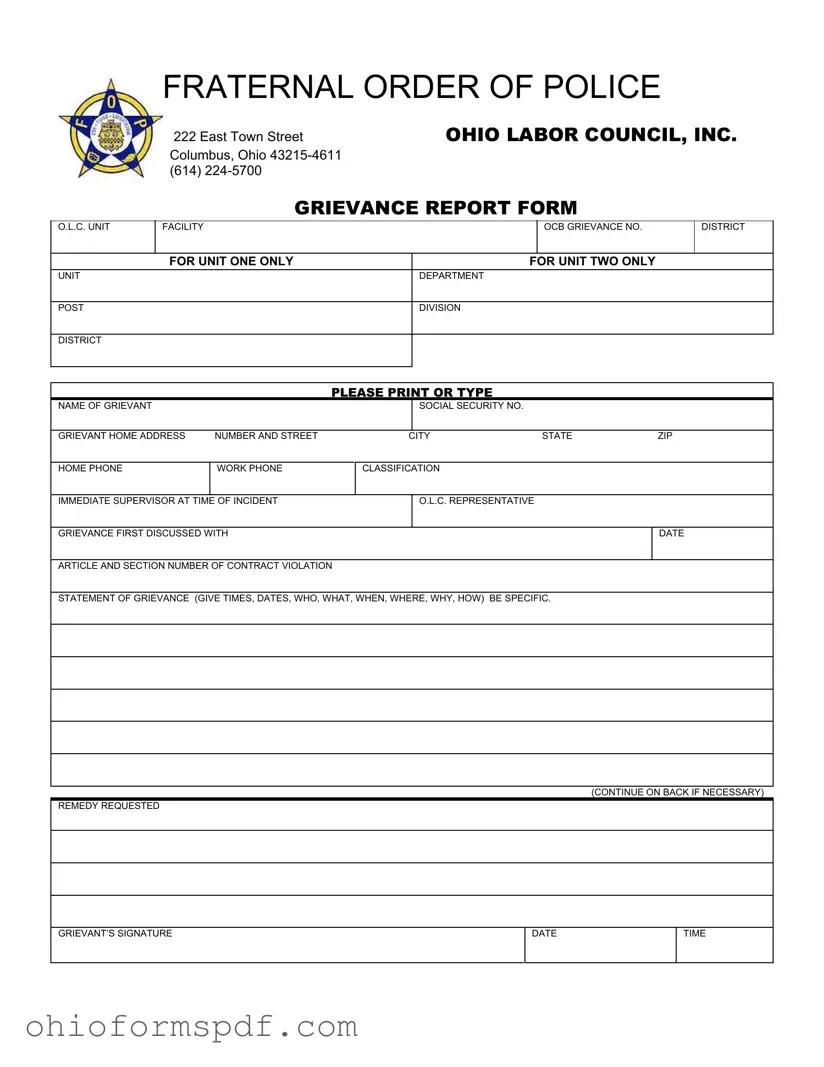The Ohio Fraternal Order of Police form shares similarities with the Employment Grievance Form circulated within various organizations to report workplace issues. Both documents are designed to officially communicate grievances related to the workplace, requiring detailed descriptions of the incident, including times, dates, and the individuals involved. They also necessitate the identification of the specific contract or policy believed to have been violated, underscoring the necessity for formal documentation in resolving workplace disputes.
Another similar document is the Union Representation Request Form, which union members use to formally request union representation in grievances or negotiating settings. Like the Ohio Fraternal Order of Police form, this document collects essential information about the member, including their name, contact information, and the nature of the grievance or negotiation, to establish a basis for representation and further action.
The Employee Discrimination Complaint Form parallels the FOP form in its purpose of formally addressing grievances, particularly those related to discrimination in the workplace. It mandates detailed accounts of alleged discriminatory acts, mirroring the grievance form’s requirement for a thorough statement of the grievance, thereby facilitating an investigation and resolution process that is both detailed and structured.
The Workers’ Compensation Claim Form is another document that bears a resemblance, primarily because it is used by employees to report work-related injuries or illnesses. Although its focus is on health-related incidents, it similarly requires detailed information about the circumstances surrounding the incident, including specific dates, times, and locations, akin to the grievance form’s emphasis on detailed incident reporting.
The Sexual Harassment Complaint Form, utilized by organizations to report instances of sexual harassment, shares similarities with the grievance form in its structured approach to detailing an incident. Both forms demand a comprehensive description of the events, including who was involved and the outcome sought by the grievant, emphasizing the importance of specific details in the resolution process.
The Employee Feedback Form, although generally used for a broader range of workplace issues, parallels the Ohio Fraternal Order of Police form in its function as a structured medium for employees to communicate concerns or suggestions to management. Both forms facilitate a formal dialogue between the employee and the organization, aiming to address workplace issues constructively.
The Performance Improvement Plan (PIP) Form also shares a procedural resemblance, as it is used to outline specific areas needing improvement for an employee, setting clear expectations and timelines. Like the grievance form, the PIP provides a structured framework for documenting concerns and steps towards resolution, albeit focused on employee performance rather than contractual violations or workplace incidents.
The Leave Request Form, commonly used by employees to request time off, shares in the grievance form’s requirement for detailed personal and situational information, even though it serves a different purpose. By requiring specific details about the leave requested, it mirrors the grievance form’s emphasis on thorough documentation for official purposes.
Last, the Workplace Safety Incident Report Form is akin to the Ohio Fraternal Order of Police form in its detailed and systematic approach to documenting incidents that occur within the workplace. It focuses on capturing precise information about the incident, including any injuries sustained and potential witnesses, reflecting the grievance form's method of documenting specific dates, times, and individuals involved in a particular issue.


